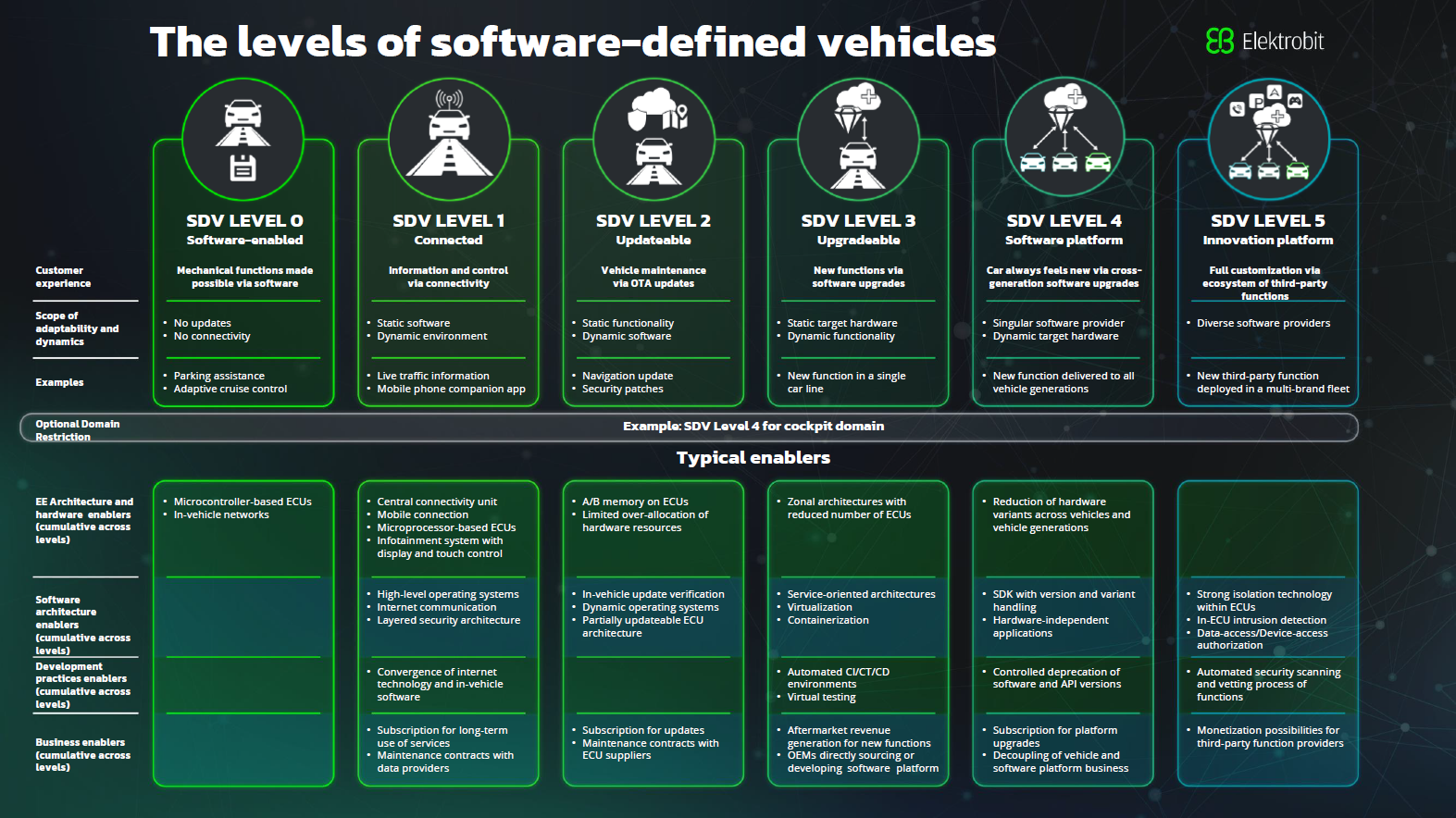
The automotive world is accelerating into a new era, driven by Software-Defined Vehicles (SDVs). These aren’t just cars; they’re platforms of possibility – constantly evolving with the software that powers them. Gone are the days when your car was just a machine that got you from points A to B. Today, the software running under the hood is transforming the entire driving experience, creating smarter, more adaptable vehicles that can adapt on the fly.
While SDVs are not simply ‘smartphones on wheels,’ they do share one crucial trait: continuous evolution through software updates. Think about how your phone is a dynamic tool, evolving with every update, adding new features or improving old ones. Now, imagine your car – a more efficient approach that integrates various vehicle functions through fewer, more powerful computing units.
The backbone: centralized architectures
At the heart of SDVs is their architecture. Imagine a car’s hardware being like the bones of the body, and the software being the nervous system that controls every movement. Traditional vehicles were like a series of isolated systems, each with its own brain and capabilities. But with SDVs, there’s a clear shift toward centralized architectures – a widely accepted approach that integrates various vehicle functions through fewer, more powerful computing units.
At the same time, a car is a complex, potentially hazardous system, which means safety and real-time functionality must be prioritized in these decisions. It’s not just about adding flashy features – it’s about ensuring software updates can happen seamlessly without compromising safety, security, or performance. This centralization goes hand in hand with separation of HW and SW.
In SDVs, major software functions are no longer tied to specific hardware components. Instead, they are dynamically deployed across available computing resources. Think of your computer. If you need to upgrade your software, you don’t need to buy a new laptop. You simply install the updates, and voilà! SDVs, with their centralized, flexible architectures, make this possible for cars. When automakers release new features or fix security vulnerabilities, it happens seamlessly over-the-air (OTA). No trips to the service center required.
Cloud connectivity and OTA updates
OTA updates are the game-changer, allowing automakers to send software updates and new features directly to your vehicle. What’s exciting about this is that these updates can enhance everything from system performance to personalization. Your car doesn’t just stay up to date – it evolves over time, adapting to your needs like a smart companion.
For example, imagine your car’s driving mode changes with a software update – what was once a sporty, responsive ride could be adjusted for a smoother, more comfortable drive when you’re heading out on a long road trip. These updates can also improve vehicle security by patching vulnerabilities, keeping your car safe from emerging cyber threats. Over time, this continual evolution makes the vehicle feel less like a static machine and more like an adaptive experience personalized for you.
Simulations: digital twins and virtual testing
Next up: the tools automakers are using to perfect these digital machines before they ever hit the road. Advanced simulation platforms allow car manufacturers to test and tweak their systems in a virtual world before building the actual car.
Imagine creating a 3D model of your car. Now, put that model into a simulated environment where you can test how it handles different weather conditions or how it reacts to an emergency situation. This is the power of “digital twins” – virtual replicas of vehicles that mirror real-world performance by processing live data.
By using these tools, manufacturers can refine their systems without the costs and time required for physical prototypes. It’s like a full dress rehearsal before opening night – a chance to identify flaws and optimize performance before real-world deployment. The result? Faster development, fewer errors, and vehicles that hit the road ready for just about anything.
Strategic considerations for manufacturers
As exciting as SDVs are, the road to success isn’t without its bumps. Manufacturers need to navigate complex challenges, from legacy systems to new regulatory landscapes. They also need to align their technology with what consumers expect from a tech-driven world. In fact, one of the key lessons for automakers is to think about SDVs not just as vehicles but as platforms for ongoing engagement.
This means manufacturers must focus on developing an adaptable, flexible product that keeps up with technological advances. To succeed, they’ll need to:
- Prioritize consumer experience, offering vehicles that are intuitive and personalized.
- Adopt agile development methods, allowing them to stay responsive to market shifts.
- Collaborate with tech companies to incorporate the latest in AI and cloud computing.
By focusing on adaptability and innovation, manufacturers can future-proof their vehicles and remain competitive in the rapidly evolving automotive market.
SDV levels
At Elektrobit, we use a structured framework – our SDV Levels – to categorize a vehicle’s progression from basic software-enabled features to a fully open innovation platform.
At Level 0 (Software-Enabled), vehicles rely on software for certain functions like Park Distance Control (PDC) or Adaptive Cruise Control (ACC), but the hardware remains static. Moving to Level 1 (Connected Vehicle), software gains connectivity, allowing for real-time data integration, such as live traffic updates or mobile app controls, though the underlying systems remain largely unchanged.
Level 2 (Updateable Vehicle) introduces over-the-air (OTA) updates, enabling remote patches and improvements without requiring a garage visit– reducing inconvenience for drivers and helping OEMs optimize service costs by addressing issues remotely. This marks the shift toward software-driven cost efficiencies.
The transition to Level 3 (Upgradeable Vehicle) happens when OEMs deliver new functions to customers after the vehicle is sold – turning technical capability into tangible benefits that excite customers. These upgrades are typically tied to specific ECUs or generations, requiring zonal architectures and service-oriented software development.
Level 4 (Software Platform) breaks the dependency between software and hardware lifecycles, making it easier to deploy software updates across multiple vehicle lines. This reduces the complexity of bringing new functionality into large fleets, paving the way for long-term, sustainable software updates without the costly effort of back-porting.
At the highest stage, Level 5 (Innovation Platform), the vehicle becomes an open ecosystem where third-party developers can create and deploy applications – similar to an app store. This level requires robust cybersecurity measures, multi-tenant software environments, and a sustainable monetization model.

By structuring SDVs into these levels, manufacturers gain a roadmap for transitioning from traditional vehicles to fully software-driven platforms, ensuring adaptability, scalability, and long-term competitiveness.
The road ahead
Software-Defined Vehicles aren’t just about futuristic gadgets and tech features – they represent a complete shift in how we think about vehicles, driving, and ownership. These vehicles are transforming from static machines to dynamic platforms continuously improving through software advancements. The future of driving isn’t just about what’s under the hood anymore – it’s about what’s running behind the scenes.
As software-defined vehicles evolve, they’re becoming smarter, safer, and more personalized. However, current SDV development is inefficient – up to 75% of software costs go toward reintegrating existing functions rather than driving innovation. The real opportunity lies in shifting investment from redundant integration work to creating scalable software architectures that maximize innovation and enhance the customer experience. A more modular, reusable software architecture will be key to making this vision a reality across all vehicle segments.
Stay tuned for more from our upcoming SDV blog series.
In the end, SDVs won’t just change the way we drive – they will redefine what it means to own and interact with a vehicle.



